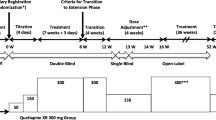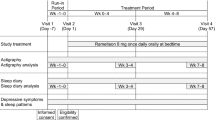Abstract
Rationale
Seasonal affective disorder (SAD) is a relatively common cyclical depressive illness characterized by seasonal depressions during winter. The disorder is commonly responsive to light therapy, but antidepressant drug efficacy has not been definitely established. Serotonin selective re-uptake inhibitors are potentially efficacious treatments for SAD.
Objectives
The objective of this study was to evaluate the efficacy, tolerability and safety of sertraline treatment for SAD.
Methods
One hundred and eighty seven outpatients with seasonal pattern recurrent winter depression (DSM-III-R defined) and a minimum 29-item Hamilton depression scale (SIGH-SAD version) score of 22 were randomized to 8 weeks treatment with either sertraline or placebo in a double-blind, multi-country, multi-center, parallel-group, flexible dose (50–200 mg once daily) study. Efficacy was investigated using physician and patient-rated scales measuring depression, anxiety and symptoms characteristic of seasonal affective disorder.
Results
Sertraline produced a significantly greater response than placebo at endpoint as measured by changes in the 29-item and 21-item Hamilton depression scales, the clinical global impression (CGI) severity scale, the Hamilton anxiety scale, and the hospital anxiety and depression scale. The proportion of sertraline-treated subjects achieving a response on the CGI improvement rating (ratings of 1 or 2) at endpoint (last observation carried forward) was significantly greater than that of the placebo group. Overall sertraline was well tolerated with the most frequent placebo adjusted adverse events, being nausea, diarrhea, insomnia and dry mouth. Adverse events were mostly mild to moderate and transient.
Conclusions
Sertraline pharmacotherapy has been demonstrated to be an effective and well-tolerated therapy for out patients with SAD. As such, sertraline offers an important pharmacological option in the clinical management of this condition.


Similar content being viewed by others
References
Blehar MC, Lewy AJ (1990) Seasonal mood disorders: consensus and controversy. Psychopharmacol Bull 26:465–494
Brewerton TD, Berrettini WH, Nurnberger JI Jr, Linnoila M (1988) Analysis of seasonal fluctuations of CSF monoamine metabolites and neuropeptides in normal controls. Psychiatry Res 23:257–265
Dilsaver SC, Qamar AB, Del Medico VJ (1992) The efficacy of bupropion in winter depression: results of an open trial. J Clin Psychiatry 53:252–255
Eastman CI, Young MA, Fogg LF, Liu L, Meaden PM (1998) Bright light treatment of winter depression: a placebo-controlled trial. Arch Gen Psychiatry 55:883–889
Fabre LF, Abuzzahab FS, Amin M, Claghorn JL, Mendels J, Petri WM, Dubé S, Small JG (1995) Sertraline safety and efficacy in major depression: a double-blind fixed-dose comparison with placebo. Biol Psychiatry 38:592–602
Fava M, Judge R, Hoog SL, Nilsson ME, Koke SC (2000) Fluoxetine versus sertraline and paroxetine in major depressive disorder: changes in weight with long-term treatment. J Clin Psychiatry 61:863–867
Garcia-Borreguero D, Jacobsen FM, Murphy DL, Joseph-Vanderpool JR, Chiara A, Rosenthal NE (1995) Hormonal responses to the administration of m-chlorophenylpiperazine in patients with seasonal affective disorder and controls. Biol Psychiatry 37:740–749
Guy W (1976) ECDEU assesment manual for psychopharmacology, revised edn. US Dept of Health, Education and Welfare Publication (ADM) 91–338. National Institute of Mental Health, Rockville, MD
Hamilton M (1959) The assessment of anxiety states by rating. Br J Med Psychol 32:50–55
Hamilton M (1960) A rating scale for depression. J Neurol Neurosurg Psychiatry 23:56–62
Kasper S (1994) Diagnostik, Epidemiologie und Therapie der saisonal abhängigen Depression (SAD). Nervenarzt 65:69–72
Kasper S, Neumeister A (1995) Treatment indications for light therapy. Acta Neuropsychiatr 7:44–46
Keller MB, Gelenberg AJ, Hirschfeld RMA, Rush, AJ, Thase ME, Kocsis JH, Markowitz JC, Fawcett JA, Koran LM, Klein DN, Russell JM, Kornstein SG, McCullough JP, Davis SM, Harrison WM (1998) The treatment of chronic depression. Part 2. A double-blind, randomized trial of sertraline and imipramine. J Clin Psychiatry 59:598–607
Klumpenhower JL, Fekkes D, van Hulst AM, Molemann P, Pepplinkhuizen L, Mulder PGH (1990) Seasonal variations in binding of 3H-paroxetine to blood platelets in healthy volunteers: indication for a gender difference. Biol Psychiatry 28:509–517
Koe BK, Weissman A, Welch WM, Browne RG (1983) Sertraline: a new selective inhibitor of serotonin uptake. Psychopharmacol Bull 19:687–691
Lam RW, Kripke DF, Gillin JC (1989) Light therapy for depressive disorders: a review. Can J Psychiatry 34:140–147
Lam RW, Gorman CP, Michalon M, Steiner M, Levitt AJ, Corral MR, Watson GD, Morehouse RL, Tam W, Joffe RT (1995) Multicenter, placebo-controlled study of fluoxetine in seasonal affective disorder. Am J Psychiatry 152:1765–1770
Lingjaerde O, Reichborn-Kjennerud T, Haggag A, Gärtner I, Narud K, Berg EM (1993) Treatment of winter depression in Norway. II. A comparison of the selective monoamine oxidase A inhibitor moclobemide and placebo. Acta Psychiatr Scand 88:372–380
Lydiard RB, Stahl SM, Hertzman M, Harrison WM (1997) A double-blind, placebo-controlled study comparing the effects of sertraline versus amitriptyline in the treatment of major depression. J Clin Psychiatry 58:484–491
Malmgren R, Åberg-Wistedt A, Martensson B (1989) Aberrant seasonal variations of platelet serotonin uptake in endogenous depression. Biol Psychiatry 25:393–402
McGrath RE, Buckwald B, Resnick EV (1990) The effect of l-tryptophan on seasonal affective disorder. J Clin Psychiatry 51:162–163
Neumeister A, Praschak-Rieder N, Hesselmann B, Rao M-L, Gluck J, Kasper S (1997) Effects or tryptophan depletion on drug-free patients with seasonal affective disorder during a stable response to bright light therapy. Arch Gen Psychiatry 54:133–138
Neumeister A, Willeit M, Praschak-Rieder N, Asenbaum S, Pirker W, Brücke T, Kasper S (2000) Seasonal variation of availability of serotonin transporter binding sites in healthy female subjects as measured by (123I)-2β-carbomethoxy-3β(4-iodophenyl) tropane and single photon emission computed tomography. Biol Psychiatry 47:158–160
O'Rourke D, Wurtman JJ, Wurtman RJ, Chebli R, Gleason R (1989) Treatment of seasonal depression with d-fenfluramine. J Clin Psychiatry 50:343–347
Parrott AC, Hindmarch I (1978) Factor analysis of a sleep evaluation questionnaire. Psychol Med 8:325–329
Partonen T (1994) Pharmacotherapy of winter seasonal affective disorder: a review. Psychiatria Fennica 25:67–72
Ravindran AV, Guelfi JD, Lane RM, Cassano GB (2000) Treatment of dysthymia with sertraline: a double-blind, placebo-controlled trial in dysthymic patients without major depression. J Clin Psychiatry 61:821–827
Reimherr FW, Chouinard G, Cohn CK, Cole JO, Itil TM, LaPierre YD, Masco HL, Mendels J (1990) Antidepressant efficacy of sertraline: a double-blind, placebo- and amitriptyline-controlled, multicenter comparison study in outpatients with major depression. J Clin Psychiatry 51[Suppl B]:18–27
Rosenthal NE, Sack DA, Gillin JC, Lewy AJ, Goodwin FK, Davenport Y, Mueller PS, Newsome DA, Wehr TA (1984) Seasonal affective disorder: a description of the syndrome and preliminary findings with light therapy. Arch Gen Psychiatry 41:72–80
Ruhrmann S, Kasper S, Hawellek B, Martinez B, Hoflich G, Nickelsen T, Moller H-J (1993) Fluoxetine as a treatment alternative to light therapy in seasonal affective disorder (SAD). Pharmacopsychiatry 26:193
Ruhrmann S, Kasper S, Hawellek B, Martinez B, Höflich G, Nickelsen T, Möller HJ (1998) Effects of fluoxetine versus bright light in the treatment of seasonal affective disorder. Psychol Med 28:923–933
Stinson D, Thompson C (1990) Clinical experience with phototherapy. J Affect Disord 18:129–135
Tam EM, Lam RW, Levitt AJ (1995) Treatment of seasonal affective disorder: a review. Can J Psychiatry 40:457–466
Terman M, Terman JS, Quitkin FM, McGrath PJ, Stewart JW, Rafferty B (1989) Light therapy for seasonal affective disorder, a review of efficacy. Neuropsychopharmacology 2:1–22
Terman JS, Terman M, Amira L (1994) One-week light treatment of winter depression near its onset: the time course of relapse. Depression 2:20–31
Thase ME, Fava M, Halbreich U, Kocsis JH, Koran L, Davidson J, Rosenbaum J, Harrison W (1996) A placebo-controlled, randomized clinical trial comparing sertraline and imipramine for the treatment of dysthymia. Arch Gen Psychiatry 53:777–784
Thompson C, Isaacs G (1988) Seasonal affective disorder—a British sample. Symptomatology in relation to mode of referral and diagnostic subtype. J Affect Disord 14:1–11
Thorell LH, Kjellman B, Arned M, Lindwall-Sundel K, Walinder J, Wetterberg L (1999) Light treatment of seasonal affective disorder in combination with citalopram or placebo with 1-year follow-up. Int Clin Psychopharmacology 14[Suppl 2]:S7–S11
Willeit M, Praschak-Rieder N, Neumeister A, Pirker W, Vitouch O, Asenbaum S, Brücke T, Tauscher J, Kasper S (2000) (123I)-β-CIT SPECT imaging shows reduced brain serotonin transporter availability in drug-free depressed patients with seasonal affective disorder. Biol Psychiatry 47:482–489
Williams JBW, Link MJ, Rosenthal NE, Terman M (1988) Structured interview guide for the Hamilton depression rating scale, seasonal affective disorders version (SIGH-SAD). New York State Psychiatric Institute, New York
Wirz-Justice A, Krauchi K, Brunner DB, Graw P, Haug H-J, Leonhardt G, Sarrafzadeh A, English J, Arendt J (1995) Circadian rhythms and sleep regulation in seasonal affective disorder. Acta Neuropsychiatr 7:41–43
Yatham LN, Lam RW, Zis AP (1997) Growth hormone response to sumatriptan (5-HT1D agonist) challenge in seasonal affective disorder: effects of light therapy. Biol Psychiatry 42:24–29
Zigmond AS, Snaith RP (1983) The hospital anxiety and depression scale. Acta Psychiatr Scand 67:361–370
Acknowledgements
This study was supported by grants from Pfizer International Inc. Scott Patten, MD, PhD, for his review of the manuscript. Dr Lane was formerly an employee of Pfizer Pharmaceuticals.
Author information
Authors and Affiliations
Corresponding author
Additional information
The authors wrote this article on behalf of the International Collaborative Group on Sertraline in the Treatment of Outpatients with Seasonal Affective Disorder.
Preliminary results from this study were presented previously at the 148th meeting of the American Psychiatric Association, Miami, Florida, 24 May 1995
Rights and permissions
About this article
Cite this article
Moscovitch, A., Blashko, C.A., Eagles, J.M. et al. A placebo-controlled study of sertraline in the treatment of outpatients with seasonal affective disorder. Psychopharmacology 171, 390–397 (2004). https://doi.org/10.1007/s00213-003-1594-8
Received:
Accepted:
Published:
Issue Date:
DOI: https://doi.org/10.1007/s00213-003-1594-8




